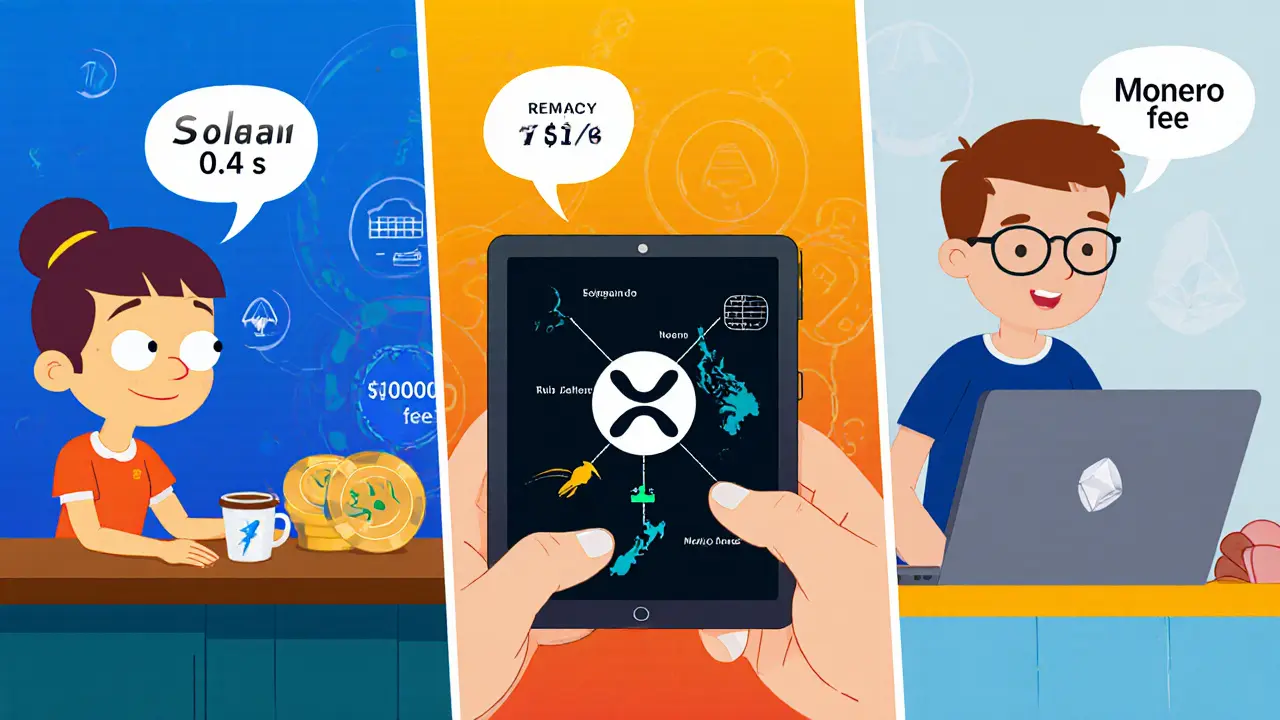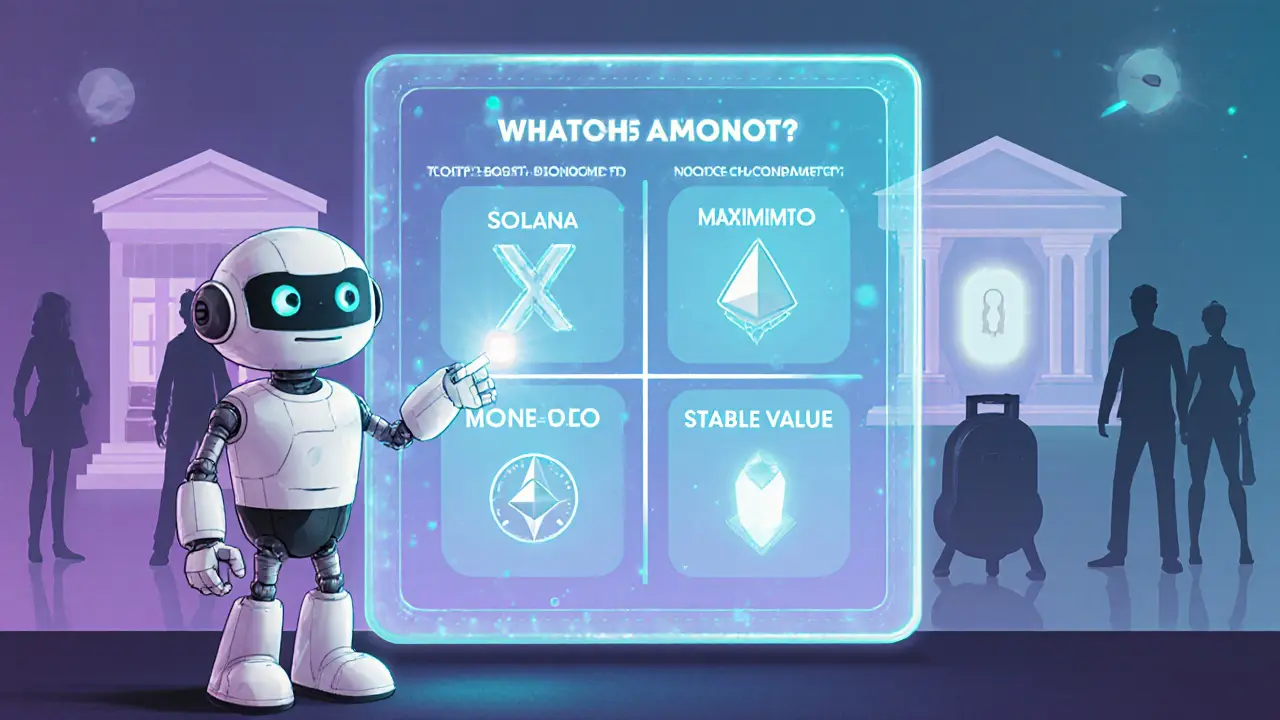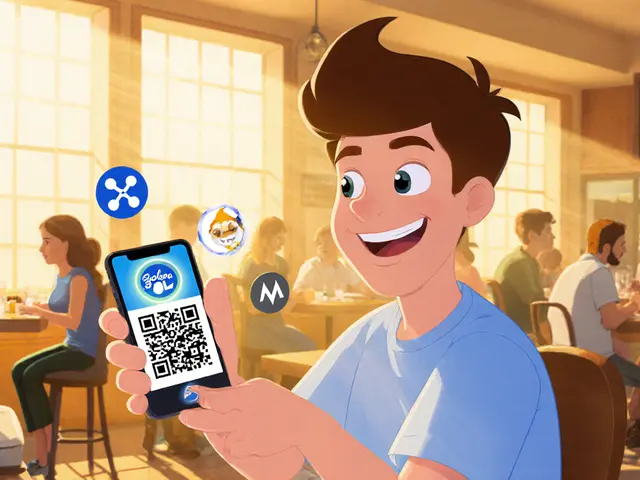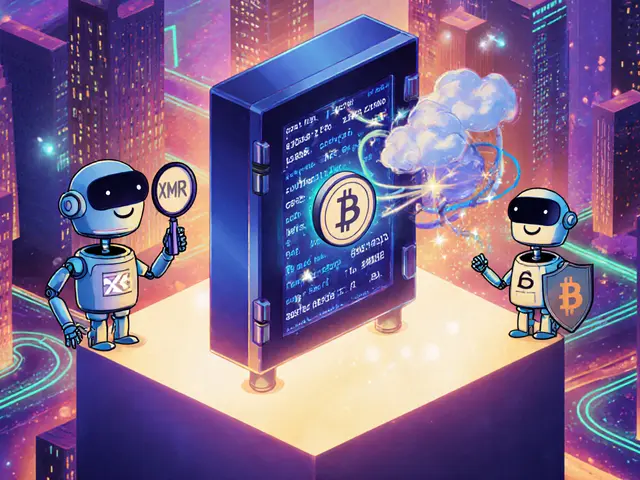Crypto Payment Fee Calculator
Calculate Your Crypto Transaction
Key Takeaways
- Solana offers sub‑second speeds and the widest merchant network for consumer purchases.
- XRP delivers ultra‑low fees and strong banking integration, making cross‑border everyday use feasible.
- Monero provides unparalleled privacy, but higher fees and slower confirmations limit micro‑transactions.
- Regulatory clarity in 2025 has reduced barriers for XRP and Solana, while stablecoin pairings improve price stability.
- Choosing the right crypto for daily payments depends on speed, cost, privacy needs, and merchant availability.
Why Everyday Crypto Payments Matter
When you pull out your phone to pay for coffee, a ride, or an online subscription, you expect a transaction to finish in seconds and cost almost nothing. Traditional cards charge processing fees that can add up, and bank transfers often take days for cross‑border moves. Payment‑focused cryptocurrencies aim to close that gap by delivering instant settlement, near‑zero fees, and global reach.
This guide breaks down the three leading digital assets that claim to be ready for everyday use, compares their technical strengths, and helps you decide which one fits your routine.
Core Players in 2025
Below are the primary entities you’ll encounter when evaluating crypto payments. Each definition includes the most relevant attributes for daily transactions.
Solana is a high‑throughput blockchain that uses a Proof‑of‑History consensus, achieving up to 65,000transactions per second (TPS) and an average block time of 400ms. Its fee average sits at $0.00025, and the network powers the Solana Pay integration on Shopify, giving merchants direct access to crypto checkout.
XRP is a digital asset built on the XRP Ledger, designed for fast, low‑cost payments. Transactions finalize in 3‑5seconds, fees stay consistently at $0.0002, and the ledger processes around 1,500TPS. Ripple, the company behind XRP, has partnered with dozens of banks worldwide.
Monero is a privacy‑centric cryptocurrency that obscures sender, receiver, and amount through ring signatures and stealth addresses. Its average fee is $0.015, and confirmation times hover around 90seconds after the May2025 Kovri integration.
Ripple is the fintech firm that develops the XRP Ledger and offers On‑Demand Liquidity (ODL) services, enabling real‑time cross‑border settlement for banks and payment providers.
Shopify is an e‑commerce platform that rolled out Solana Pay in Q12025, allowing over 2million merchants to accept SOL directly at checkout.
USDC is a stablecoin pegged 1:1 to the US dollar, increasingly used alongside Solana and XRP to mitigate price volatility in everyday purchases.
Stablecoin refers to any crypto asset that maintains a stable value, typically by being backed by fiat currency or collateral, and is a common pairing to smooth out price swings for payment‑focused tokens.

Technical Snapshot
Understanding raw numbers helps you gauge whether a blockchain can handle a coffee‑shop queue or a high‑volume online sale.
| Metric | Solana (SOL) | XRP | Monero (XMR) |
|---|---|---|---|
| Average confirmation time | 0.4seconds (sub‑second finality) | 3‑5seconds | ≈90seconds (post‑Kovri) |
| Fees (typical) | $0.00025 (spikes to $0.001 peak) | $0.0002 (flat) | $0.015 (max $0.05) |
| Throughput (TPS) | ≈65,000 (potential 1.2M with Firedancer) | ≈1,500 | ~ 250 (limited by privacy overhead) |
| Merchant adoption (2025) | 3.4M global merchants (incl. Shopify) | 1.2M (mainly via banking APIs) | ~1,850 physical locations |
| Privacy rating | 7/10 (transparent ledger) | 10/10 (full anonymity) | 9/10 (strong but slightly less than Monero) |
Speed vs. Stability: Real‑World Use Cases
Solana shines when you need instant checkout at a brick‑and‑mortor store or a fast‑moving e‑commerce site. A coffee shop in Auckland reported 2‑second confirmations for SOL payments, and a Shopify merchant processed 217 coffee orders in a single day with zero failures. The occasional network hiccup (a 3‑hour outage in Q12025) is a risk, but the platform’s developer community quickly patched the issue, and the upcoming Firedancer client promises higher resilience.
XRP excels in cross‑border remittances. Sending money from NewZealand to the Philippines via a participating bank settled in just over 4seconds, and the fee was barely noticeable. For everyday domestic purchases, however, the need for a destination tag adds friction-about 7% of new users report errors when entering the tag.
Monero is the go‑to choice if you value privacy above all. A user buying privacy‑focused services online could hide the transaction completely, but the 90‑second confirmation makes it impractical for pay‑at‑the‑pump scenarios. The higher fee also means a $5 coffee purchase would cost an extra $0.15, which feels steep compared to SOL or XRP.
How to Get Started
- Choose the wallet that matches your comfort level.
- For Solana, the Phantom mobile app offers a 4.7/5 ease‑of‑use rating and a simple QR‑code payment flow.
- XRP users can start with Exodus, which abstracts destination tags by generating a payment‑request link.
- Monero newcomers often pick Monerujo on Android; it guides you through address creation and fee selection.
- Buy the token on a regulated exchange (e.g., Binance, Kraken) and transfer it to your wallet.
- Link the wallet to a payment processor if you’re a merchant. Shopify’s Solana Pay integration requires only a few clicks to embed a SOL checkout button.
- Test a small transaction (under $10) to confirm your setup works. Pay attention to confirmation time and any fee surprises.
- Consider pairing with a stablecoin like USDC on Solana or XRP Ledger to lock in price during volatile periods.
Most users report the entire onboarding process taking 8-12minutes for Solana, while XRP’s extra step for destination tags can add a couple of minutes. Monero’s steep learning curve means many need help from community forums; about 68% of newcomers seek assistance during the first setup.

Risk Factors & Mitigation
- Volatility: Even payment‑focused tokens swing in price. Pairing with USDC or another stablecoin eliminates the risk for everyday purchases.
- Network reliability: Solana’s occasional outages require a fallback payment method (e.g., credit card) for critical transactions.
- Regulatory scrutiny: XRP’s SEC case resolved in early 2025, but future policy shifts could affect banking integrations. Stay updated through official Ripple announcements.
- User error: Destination tags (XRP) and large transaction sizes (Monero) are common pitfalls. Using wallet‑generated payment links reduces manual entry mistakes.
Future Outlook
By 2026, Gartner predicts Solana will capture roughly 31% of consumer crypto payment volume, thanks to its expanding merchant network and the upcoming Firedancer upgrade that could push TPS beyond 1million. XRP is expected to dominate institutional cross‑border use, with Ripple aiming to add 500k merchants by early 2026 through HookV2. Monero’s niche privacy market will likely stay small (around 5% of crypto payments) but could grow if regulatory frameworks become more permissive.
Stablecoin integration is the biggest catalyst for mainstream adoption. Both Solana Pay and Ripple have rolled out USDC support, letting users lock in a dollar value at the point of sale while still benefiting from fast settlement.
Choosing the Right Crypto for Your Daily Life
Use the quick decision matrix below to match your priorities with the best token.
| Priority | Best Cryptocurrency | Why |
|---|---|---|
| Fastest checkout & widest merchant coverage | Solana (SOL) | Sub‑second finality, 3.4M merchants, easy mobile wallets. |
| Cross‑border remittance with ultra‑low fees | XRP | 3‑5s settlement, $0.0002 fee, deep banking integration. |
| Maximum privacy for everyday purchases | Monero (XMR) | Ring signatures & stealth addresses, 98.7% untraceable. |
| Price stability while keeping crypto speed | USDC on Solana or XRP Ledger | Dollar‑pegged, instant settlement, low fees. |
Frequently Asked Questions
Can I use Solana to pay for groceries today?
Yes, if the grocery store supports Solana Pay or a third‑party processor that works with SOL. The transaction will typically confirm in under a second and cost less than a tenth of a cent.
Do I need a destination tag for every XRP payment?
A destination tag is required whenever the receiving address belongs to an exchange or a service that manages multiple users under one address. Wallets that generate payment links can embed the tag automatically, eliminating manual entry.
Is Monero practical for buying a coffee?
It works, but the 90‑second confirmation and $0.015 fee make it less convenient than SOL or XRP for tiny purchases. If privacy is your top concern and you’re willing to wait, Monero can be used.
How do stablecoins fit into everyday crypto payments?
Stablecoins like USDC lock the value to a fiat currency, so you avoid price swings while still benefiting from instant blockchain settlement. Both Solana and XRP Ledger support USDC, letting you pay in a dollar‑stable form and optionally convert to SOL or XRP later.
What should I do if my SOL payment fails during a network outage?
Check Solana’s status page; outages are usually resolved within minutes. Meanwhile, have a fallback option like a card or another crypto (e.g., XRP) ready. Once the network is back, the failed transaction can be retried.



Comments
Hey folks, just wanted to say that the fee calculator is a great tool-don’t forget to double‑check the network fees, especially when using Solana or XRP. If you’re new, start with a small amount to see how fast the transaction confirms. Also, keep an eye on the stablecoin USDC if you need price stability. Happy transacting! (definately)
Oh wow, thanks for the tutorial, Andrew-because I was totally lost on how to press a button. 🙄
Listen up, crypto newbies: if you think any of those coins are just a game, you’re dead wrong. Solana’s lightning speed can shave seconds off your purchase, but only if you keep your wallet updated. XRP still fights the legacy banking system, and Monero gives you the privacy you claim you want. Stop whining and start using the right coin for the job!
Russel, chill a bit. The guide actually helps people avoid costly mistakes. Just remember that fees aren’t the only thing-security matters, too.
Crypto might be shiny, but don’t let greed blind you-use what’s legit and keep it simple.
While I appreciate the comprehensive overview, it is imperative to acknowledge that the United States’ regulatory framework encourages the adoption of stablecoins such as USDC, thereby fostering financial stability.
Sure, the calculator looks clean, but have you considered that the data could be manipulated by the shadowy groups controlling the blockchain nodes? They might be feeding us false fee numbers to steer us towards certain tokens.
Bruce, your paranoia is noted, yet the open‑source nature of the code offers some transparency that counters those fears.
i think this is realy helpful for everyday spendings, just make sure to check the gas before you pay.
Nice tool! 🚀💰
The exposition provided herein exemplifies a commendable synthesis of market analytics and pragmatic utility, yet it remains incumbent upon the discerning investor to evaluate the underlying macroeconomic vectors that influence transaction throughput.
Indeed, DeAnna, and let me add that the imminent Ethereum Shanghai upgrade will further diminish fees on ERC‑20 tokens, rendering the current fee landscape obsolete within months.
This guide is another piece of hype that tries to make crypto sound feasible for the average Jane and John.
The reality is that most of these so‑called everyday payments still cost more than a latte.
Take Solana, for example – they brag about micro‑transactions, yet the network is plagued by frequent downtimes.
XRP claims to be the bridge currency, but it’s still entangled in legal battles that could freeze your funds.
Monero offers privacy, but the transaction time can stretch to minutes, not seconds.
USDC is stable, but you still need to trust a central issuer, which defeats the purpose of decentralization.
The fee calculator, while flashy, oversimplifies the complex fee structures that vary by time of day.
People forget that network congestion can spike fees dramatically within minutes.
Moreover, the guide ignores the hidden costs of bridge fees when moving assets between chains.
Your wallet software might also charge a service fee that isn’t reflected here.
If you’re looking to pay for groceries, you’re better off using a debit card with zero‑fee rewards.
Crypto still lacks the consumer protections that traditional payment rails provide.
Regulatory uncertainty adds another layer of risk that this article glosses over.
In short, treat this calculator as a novelty rather than a reliable financial tool.
Proceed with caution, and don’t let marketing hype dictate your spending habits.
Shauna raises valid concerns; nevertheless, for users prioritizing speed over cost, Solana still presents a compelling option, provided they monitor network health.
The proliferation of such calculators signifies a maturing ecosystem, yet one must remain vigilant of the underlying volatility that could erode any perceived benefit.
Absolutely, Shrey. The tool serves as a useful baseline, but always double‑check the latest network stats before committing.
When contemplating digital payments, one might reflect on the paradox of seeking frictionless transactions within an inherently decentralized framework, where trust is distributed rather than centralized.
💡Pro tip: Keep your app updated to snag the lowest fees! 🚀
While everyone touts the convenience of crypto, I contend that the true cost lies not in the transaction fee but in the opportunity loss incurred by diverting capital into a volatile asset class.
Gautam, your perspective invites a deeper inquiry into the nature of value itself, prompting us to question whether monetary efficiency should supersede the philosophical implications of digital scarcity.